Shiken: JALT Testing & Evaluation SIG Newsletter
Vol. 14 No. 2. Oct. 2010. (p. 30 - 35) [ISSN 1881-5537]
How are PCA and EFA used
|
 James Dean Brown University of Hawai'i at Manoa |
[ p. 30 ]
| Variables | Rotated 2 Factors (with Thinking extraversion) | Rotated 2 Factors (without Thinking extraversion) | ||||
| Factor 1 | Factor 2 | h2 | Factor 1 | Factor 2 | h2 | |
| Social extraversion | -0.108 | 0.668 | 0.458 | -0.142 | 0.660 | 0.456 |
| Ascendance | -0.086 | 0.553 | 0.314 | -0.113 | 0.548 | 0.313 |
| Thinking extraversion | -0.064 | -0.019 | 0.005 | |||
| Rhathymia | 0.405 | 0.573 | 0.493 | 0.381 | 0.596 | 0.501 |
| General activity | -0.191 | 0.692 | 0.515 | -0.225 | 0.680 | 0.513 |
| Lack of agreeableness | 0.139 | 0.527 | 0.297 | 0.116 | 0.535 | 0.299 |
| Lack of cooperativeness | 0.468 | 0.013 | 0.219 | 0.468 | 0.036 | 0.220 |
| Lack of objectivity | 0.607 | 0.018 | 0.368 | 0.602 | 0.045 | 0.364 |
| Nervousness | 0.754 | -0.199 | 0.608 | 0.762 | -0.164 | 0.608 |
| Inferiority feelings | 0.656 | -0.494 | 0.675 | 0.762 | -0.164 | 0.608 |
| Cyclic tendencies | 0.792 | 0.077 | 0.633 | 0.786 | 0.114 | 0.677 |
| Depression | 0.773 | -0.257 | 0.664 | 0.783 | -0.221 | 0.662 |
| Proportion of Variance | 0.255 | 0.183 | 0.437 | 0.258 | 0.179 | 0.477 |
[ p. 31 ]

| Variables | Rotated PCA 2 Components | Rotated EFA 2 Factors | ||||
| Comp 1 | Comp 2 | h2 | Factor 1 | Factor 2 | h2 | |
| Social extraversion | -0.150 | 0.737 | 0.566 | -0.142 | 0.660 | 0.456 |
| Ascendance | -0.116 | 0.654 | 0.441 | -0.113 | 0.548 | 0.313 |
| Rhathymia | 0.419 | 0.656 | 0.605 | 0.381 | 0.596 | 0.501 |
| General activity | -0.238 | 0.740 | 0.605 | -0.225 | 0.680 | 0.513 |
| Lack of agreeableness | 0.150 | 0.649 | 0.443 | 0.116 | 0.535 | 0.299 |
| Lack of cooperativeness | 0.565 | 0.065 | 0.065 | 0.468 | 0.036 | 0.220 |
| Lack of objectivity | 0.687 | 0.065 | 0.476 | 0.602 | 0.045 | 0.364 |
| Nervousness | 0.799 | -0.170 | 0.668 | 0.762 | -0.164 | 0.364 |
| Inferiority feelings | 0.703 | -0.471 | 0.715 | 0.681 | -0.462 | 0.608 |
| Cyclic tendencies | 0.819 | 0.117 | 0.684 | 0.786 | 0.114 | 0.677 |
| Depression | 0.812 | -0.226 | 0.711 | 0.783 | -0.221 | 0.662 |
| Proportion of Variance | 0.322 | 0.245 | 0.567 | 0.282 | 0.195 | 0.477 |
[ p. 32 ]

[ p. 33 ]

[ p. 34 ]
[ p. 35 ]